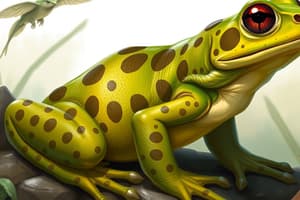Podcast
Questions and Answers
What are the three orders of Class Amphibia? Give an example of each.
What are the three orders of Class Amphibia? Give an example of each.
Caudata (salamanders and newts), Gymnophiona (caecilians), Anura (frogs)
What were the 8 MAIN characteristics of Class Amphibia?
What were the 8 MAIN characteristics of Class Amphibia?
- Living a double life, 2. Tetrapods - 4 legs, 3. Restricted to moist habitat, 4. Oviparous (no amniotic eggs with shells), 5. Skin with mucoid secretions, 6. Lack epidermal scales, feathers, or hair, 7. Larvae are aquatic and undergo metamorphosis, 8. Two atrial chambers in the heart
What keeps an amphibian's egg from being dried out by the sun?
What keeps an amphibian's egg from being dried out by the sun?
The fluid in the sac keeps the embryo moist.
In which order is almost half of the species found in North America?
In which order is almost half of the species found in North America?
What are characteristics of Order Caudata?
What are characteristics of Order Caudata?
What is the 'amphibian trick' for keeping eggs protected?
What is the 'amphibian trick' for keeping eggs protected?
In what kind of habitat do amphibians live?
In what kind of habitat do amphibians live?
What are characteristics of Order Anura?
What are characteristics of Order Anura?
What are characteristics of Order Gymnophiona?
What are characteristics of Order Gymnophiona?
Gymnophiona are near blind because their skin covers their eyes.
Gymnophiona are near blind because their skin covers their eyes.
What is the name of the species classified in Order Gymnophiona?
What is the name of the species classified in Order Gymnophiona?
Why do Gymnophiona appear segmented like a worm?
Why do Gymnophiona appear segmented like a worm?
What other worm-like quality do Gymnophiona have?
What other worm-like quality do Gymnophiona have?
What are the functions of amphibians' skin?
What are the functions of amphibians' skin?
What does amphibian skin lack?
What does amphibian skin lack?
What factors determine what amphibians eat?
What factors determine what amphibians eat?
Describe how amphibians catch their prey.
Describe how amphibians catch their prey.
Why does it cost aquatic organisms MORE energy to breathe than it does terrestrial organisms?
Why does it cost aquatic organisms MORE energy to breathe than it does terrestrial organisms?
Flashcards are hidden until you start studying
Study Notes
Classes of Amphibians
- Three orders of Class Amphibia are Caudata (salamanders and newts), Gymnophiona (caecilians), and Anura (frogs).
Characteristics of Amphibians
- Amphibians exhibit a double life, typically alternating between aquatic larval and terrestrial adult stages.
- They are tetrapods, possessing four limbs.
- They require moist habitats due to their skin's permeability.
- Amphibians are oviparous, laying eggs without amniotic shells.
- Their skin secretes mucus to maintain moisture, lacking scales, feathers, or hair.
- Larvae are exclusively aquatic and undergo metamorphosis to become terrestrial adults.
- Their cardiovascular system consists of two atrial chambers in the heart.
Reproductive Adaptations
- Amphibian eggs are protected by a fluid-filled sac to prevent desiccation, as they lack amniotic eggs found in reptiles and birds.
- Northwestern Salamanders use a unique strategy by laying jelly-like egg masses in water, which swell significantly when hydrated, providing warmth and protection from predators.
Habitat and Lifestyle
- Amphibians predominantly inhabit moist environments, as their skin requires constant moisture.
Order-Specific Characteristics
Caudata
- Caudata translates to "tail bearer," and members retain tails throughout their lives.
- They possess two pairs of unspecialized legs.
- Most terrestrial species prefer moist forest floor habitats.
- Larval stages are aquatic, while some adults, like newts, remain in water for most of their lives.
- Internal fertilization is observed in this order.
Anura
- Anura means "without a tail," characterizing adult frogs and toads.
- They primarily inhabit moist locations, with a few species adapting to deserts.
- Anurans are recognized by their long, muscular hindlimbs and webbed feet, aiding in jumping and swimming.
- Fertilization is external, and larvae develop in aquatic environments.
- Toads are recognized as anuran species with dry, warty skin; they tend to be more terrestrial than frogs.
Gymnophiona
- Gymnophiona translates to "naked snake," indicating their worm-like appearance.
- They primarily live in tropical environments and are burrowers.
- Their skin gives a segmented appearance, due to folds, and they are nearly blind as their eyes are covered by skin.
- They possess a retractile tentacle, aiding in sensory perception due to poor eyesight.
- Fertilization can be both internal; these creatures can be oviparous or viviparous.
Feeding and Predation
- Skin functions include gas exchange, temperature regulation, water absorption, protection from infections, UV light, and physical injuries.
- Amphibian skin lacks protective coverings such as scales, feathers, or hair.
- Feeding is influenced by prey size and availability, with larvae being herbivorous and adults typically carnivorous.
- Prey capture involves lunging, using a sticky tongue to immobilize prey against the mouth, and swallowing relies on eye movement to aid in pushing food towards the esophagus.
Energy Costs in Respiration
- Breathing in aquatic organisms demands more energy compared to their terrestrial counterparts, although the exact reasons were not specified.
Studying That Suits You
Use AI to generate personalized quizzes and flashcards to suit your learning preferences.



